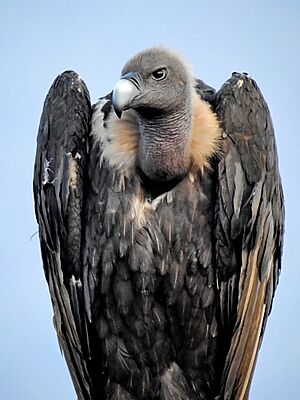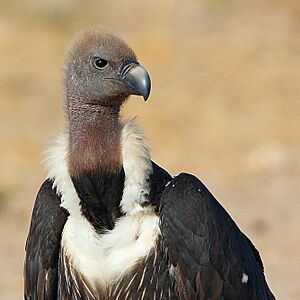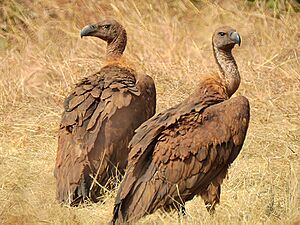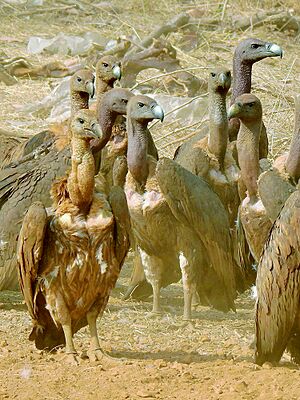White-rumped vulture facts for kids
Quick facts for kids White-rumped vulture |
|
|---|---|
 |
|
| White-rumped vulture in Mangaon, Raigad, Maharashtra | |
| Conservation status | |
| Scientific classification | |
| Genus: |
Gyps
|
| Species: |
bengalensis
|
 |
|
| Former distribution of the white-rumped vulture in red | |
| Synonyms | |
|
Pseudogyps bengalensis |
|
The white-rumped vulture (Gyps bengalensis) is a large bird of prey found in South and Southeast Asia. It is a type of Old World vulture. Sadly, this vulture is now Critically Endangered. This means its numbers have dropped very, very low.
Since 2000, it has been on the IUCN Red List of endangered species. The main reason for this big decline is a medicine called diclofenac. This medicine, used for farm animals, poisons the vultures when they eat dead animals. It causes their kidneys to fail.
In the 1980s, there were millions of white-rumped vultures. People thought it was the most common large bird of prey in the world. But by 2021, there were fewer than 6,000 adult vultures left. This shows how quickly their population has disappeared.
This vulture is related to the European griffon vulture. It was once called the "Oriental white-backed vulture" because people thought it was closer to the white-backed vulture from Africa.
Contents
How Scientists Name and Group Animals
The white-rumped vulture was first officially described in 1788. A German scientist named Johann Friedrich Gmelin gave it the scientific name Vultur bengalensis. He put it in the group of vultures called Vultur.
Gmelin based his description on a bird seen by an English bird expert, John Latham. Latham had seen a live vulture at the Tower of London. He was told it came from Bengal. Today, the white-rumped vulture is one of eight species in the group called Gyps. This group name comes from an old Greek word for "vulture."
What White-Rumped Vultures Look Like
The white-rumped vulture is a medium-sized vulture. It has a head and neck without feathers. Its wings are very wide, and its tail feathers are short. It is smaller than the European Griffon vulture.
Adult vultures have a white neck ruff, which is like a collar of feathers. Their back, rump (bottom), and the feathers under their wings are whitish. This contrasts with their dark body. The body is black, and some wing feathers are silvery grey. Their head has a pinkish color, and their beak is silvery with dark parts.
Young vultures are mostly dark. It takes them about four or five years to get their adult colors. When flying, adults show a dark front edge on their wings. They also have a white lining on the underside of their wings.
This vulture is the smallest of the Gyps vultures. But it is still a very large bird. It weighs between 3.5 and 7.5 kilograms (7.7 to 16.5 pounds). It is about 75 to 93 centimeters (30 to 37 inches) long. Its wings can spread out from 1.92 to 2.6 meters (6.3 to 8.5 feet) wide.
Where They Live and What They Eat
White-rumped vultures build their nests on tall trees. They often nest near towns and villages in places like India, Pakistan, Nepal, Bangladesh, and Southeast Asia. They usually lay one egg. These birds often gather in groups to rest together. Most of them stay in the same area all year.
Like other vultures, they are scavengers. This means they eat mostly dead animals. They find food by flying high in warm air currents called thermals. From up high, they can spot other animals that are also looking for food. They often fly and sit in large groups. Long ago, they were the most common vulture in India.
Behavior and Life Cycle

White-rumped vultures usually become active when the morning sun warms the air. This creates enough warm air currents for them to soar easily. They used to be seen in huge numbers above cities like Calcutta.
When they find a dead animal, they quickly fly down and eat a lot. They might also perch on nearby trees. Sometimes, they even come down after dark to feed. When many vultures are at a feeding spot, larger birds like red-headed vultures usually get to eat first.
In forests, if you saw these vultures soaring, it often meant a Bengal tiger had made a kill. They can even swallow small, dry bones from animals. If water is nearby, they regularly bathe and drink. A group of vultures can clean up a whole dead cow in about 20 minutes!
Trees where they often rest become white from their droppings. This can make the trees sick and sometimes even kill them. Because of this, people didn't always want them in fruit farms.
Reproduction
White-rumped vultures used to build "hundreds of nests" on large trees near people. They preferred trees like Banyan, Peepul, Arjun, and Neem. The main time for nesting was from November to March, with most eggs laid in January. Several pairs often nest close to each other. Younger birds might build their nests alone. Nests are lined with green leaves.
In one nature reserve, vultures mostly used Terminalia arjuna and Spondias mangifera trees for nesting. Their nests were about 26.73 meters (87.7 feet) high. The nests were about 1 meter (3.3 feet) long, 40 centimeters (1.3 feet) wide, and 15 centimeters (0.5 feet) deep. Chicks were seen hatching in early January.
The male vulture brings twigs to build the nest. During courtship, the male gently touches the female's head, back, and neck with his beak. The female usually lays one egg. The egg is white with a bluish-green tint. If an egg is lost, the female might destroy the nest.
Vultures are usually quiet. But they can make hissing and roaring sounds at the nest or when fighting for food. The eggs hatch after about 30 to 35 days. The young chick is covered with soft grey feathers. The parents feed them small pieces of meat. The young birds stay in the nest for about three months.
A white-rumped vulture kept in a zoo lived for at least 12 years.
Why They Are Disappearing
In India and Nearby Countries
The white-rumped vulture was once very common in India. People often saw them nesting on trees along roads in big cities. Before the 1990s, they were so common that they were sometimes a problem for airplanes, causing bird strikes.
But since the early 1990s, the number of white-rumped vultures has dropped by 99% in India and nearby countries. This huge decline is mainly due to poisoning from diclofenac. This medicine is a painkiller given to farm animals like cows. When these animals die, and vultures eat their bodies, the diclofenac causes the vultures' kidneys to fail.
Scientists found that diclofenac was deadly even in small amounts to Gyps vultures. Between 2000 and 2007, the vulture population in India dropped by about 43.9% each year.
In Southeast Asia
In Southeast Asia, white-rumped vultures started disappearing even before the diclofenac problem. This was likely because there were fewer large wild animals for them to eat. Also, people started managing dead farm animals better, so there were fewer carcasses left for the vultures.
Helping White-Rumped Vultures
Today, only the vulture populations in Cambodia and Burma are thought to be healthy enough to survive, but they are still very small. Scientists have suggested using a different medicine called meloxicam for farm animals. Meloxicam is a painkiller like diclofenac, but it is much safer for vultures.
Many countries in South Asia are working to ban the use of diclofenac for animals.
Efforts to save the vultures include:
- Releasing birds back into the wild: This means raising vultures in special centers and then letting them go.
- Captive-breeding programs: These programs breed vultures in safe places to increase their numbers.
- "Vulture restaurants": These are safe places where clean, diclofenac-free carcasses are left out for vultures to eat.
In 2007, two white-rumped vulture chicks hatched in a special facility. They were the first ever to be bred in captivity. Sadly, they died after a few weeks. This sometimes happens with young bird parents who are breeding for the first time.
|






